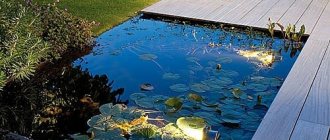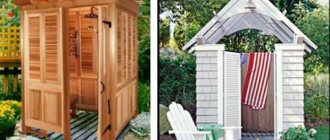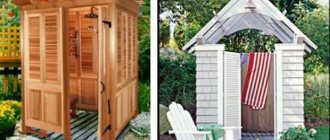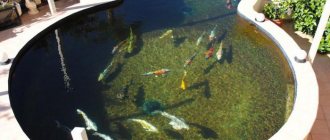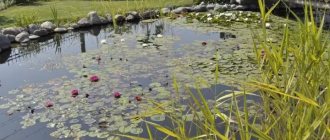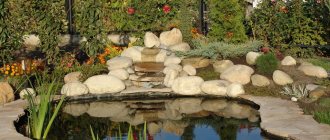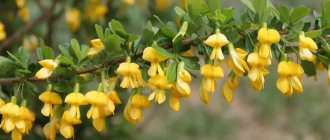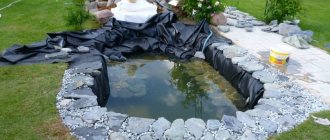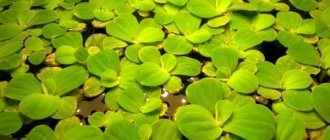A pond is a wonderful decoration of any site, a fashionable element of landscape design. Nymphs, marsh irises, reeds, calamus and other aquatic plants look great in the water. You can create a pond in a small area by arranging a picturesque place for relaxation.
Konstantin Khokh , creator of the WaterLilia nursery, is a passionate nymph breeder. He willingly shares his experience in growing aquatic plants and gives valuable recommendations regarding the construction of artificial reservoirs. At the moment, the WaterLilia nursery has already created 20 ponds in which water lilies of incredible beauty grow. The word goes to the owner of the water gardens.
– In this material I will try to help you not make mistakes when creating a reservoir in which nymphs will be grown. I will not describe the stages of construction, but will only suggest what needs to be taken into account when planning the work. We will consider only artificial reservoirs using a waterproofing membrane.
How to make a natural pond?
First, let's define what is meant by this phrase:
- A natural pond is a man-made natural body of water that contains silt, plants, microorganisms, and small fish.
- Fills without human intervention: flowing rainwater, underground springs, groundwater, stream flowing through the site.
- Plants and microflora prevent the processes of water decay, it purifies itself.
How to choose a place and what to provide:
- distance from trees and tall bushes. Leaves and branches should not clog the water;
- good lighting, direct rays of the sun throughout the daylight hours are unacceptable;
- correctly located in a low area so that rainwater does not spill over the area, but flows into the pond;
- choose a flat area with a slight slope.
What to consider so that the reservoir is “alive” and does not rot:
- Water should not seep in or go away. Ideal soil is clay and loam;
- extend the reservoir in the direction of the main winds so that the water fluctuates and is naturally saturated with oxygen;
- the shape of the pond is close to what exists in nature: irregular;
- the angle of inclination to the shore is 45 degrees, it is good to arrange a terrace (step) under water on which to plant plants;
- the depth is not the same: in the north it is deeper; in the south – smaller, from 0.5 m.
- A natural pond must be saturated with oxygen, otherwise it will bloom. The rich microflora easily copes with this task. The shallow water warms up well, and amphibians breed in it. Silt, stones, and driftwood create different environments and stimulate the emergence of diverse life.
Making a pond
A properly made pond occupies at least 10th of the site. Deep - it warms up poorly and is simply dangerous, shallow - it blooms. On the forums of summer residents, the optimal size of a reservoir is recommended to be 2.5 - 3 m in diameter, 1.5 m in depth. The hole is dug manually or using machinery. Next, waterproofing is done.
Ecopond - involves natural waterproofing, called a clay castle. Only this natural material contributes to the functioning of a living ecological system. This is a good way to make a pond without film:
- Only fatty clay is suitable for these purposes ; there should be little sand in it, otherwise it will crack over time and the water will gradually drain away.
- Kneaded clay is laid out in layers on the bottom and walls of the pit, then compacted, allowed to dry, and another layer is applied. There should be three of them, each 15 cm thick .
- Next come large stones, then small ones, and finally river sand.
The advantages of having a reservoir at your summer cottage and why it is needed
You can always make your site even more beautiful. You can attract songbirds to it, admire the water sparkling in the sun, and admire the delicate flowers of water lilies using an artificial pond in the garden. Of course, nothing bad will happen if such beauty is not on your site. But how much more advantageous and luxurious look gardens in which an important place is reserved for water - the basis of our life!
The pond at the dacha immediately attracts attention
Advantages of placing a decorative pond in the country:
- this is an important component of landscape design, which brings the image of a natural area into the garden;
- new plants appear in the garden that will inhabit the pond itself and the plot of land around it;
- due to the reservoir, air humidity increases, which has a beneficial effect on the health of the plants surrounding the pond;
- this is an additional place where you can rest your soul;
- if the reservoir is large and deep enough, then many species of fish will feel great in it;
- a pond makes the landscape even more interesting, especially due to the crossover bridge or fountain.
We organize the child’s leisure time: playgrounds for the dacha. In a special publication on our portal, we will talk in detail about how to organize a children's playground in the country. You will learn how to choose coverage and equipment for a site, about safety requirements and view a photo gallery of sites.
How to make a small pond?
There are several simple ways to arrange miniature ponds on your site.
- We follow the method of creating natural reservoirs. A small pit is dug at an angle, with small sides for planting plants. The bottom is lined with a layer of sand, then lined with film so that the edges extend onto a flat surface of the ground, and secured with stones. We lay stones on top of the film, give the artificial turf the opportunity to settle down, take shape, and then add water.
- An old bathtub, pre-treated for corrosion, will do. Water can be easily changed using a drainage pipe through the drain hole.
- Special forms designed for artificial reservoirs. They have several levels and vary in shape and size.
Since the shape is a wave-like configuration, transitions during burial are taken into account. Special steps are made, one wider than the other. After installation, the voids are filled with earth.
The form is set slightly above ground level, a layer of sand of approximately 20-30 cm is poured under it, but first markings are made on the ground. Then you can start digging a pit. How to do this can be clearly seen in the pictures below.
Materials for production
It is important to remember about soil waterproofing. In its absence, the pond will quickly become polluted due to the formation of sludge.
Therefore, you need to carefully select the material for the future artificial reservoir. It can be made using:
- concreting the base;
- films;
- polymer container;
- plastic form of any size;
- barrels or old bathtubs.
Film for reservoirSource vodoem99.ru
Some of these materials and containers require special preparation before installation. You should study all the features of the material, become familiar with the advantages and disadvantages in order to understand the feasibility of installing the equipment.
How to make a big pond?
- First, outline the contours. For irregular shapes, a regular rope will do; for a rectangle, square - hammer in pegs and stretch a string between them.
- An excavator is used to dig a pit. You can calculate its dimensions using the formula for calculating the volume of a truncated cone. This can be easily done on a site like fxyz.ru. You just need to insert the numbers into the required line.
- Next, they level the walls of the dug bowl and make them flat . Provide terraces around the perimeter of the reservoir. They prevent the soil from crumbling and serve as convenient steps when laying waterproofing. They will be useful in the future when decorating a pond.
Important! Three zones are provided in the pit bowl: deep, 1.8-2.0 meters (below the freezing level of the ground). It is prepared for fish so that it can successfully overwinter. Medium – for plants. Small – in summer such places warm up well, fry and living creatures accumulate here, and microflora multiplies.
If you are digging a pond for swimming, you do not need to deepen the bottom, it is made smooth.
Next you need:
- remove stones and driftwood from the bottom;
- prepare waterproofing material.
recommends first filling the bottom with sand and laying geotextiles on top.
Among the existing options for waterproof coatings, butyl rubber film is usually chosen. The main argument is durability. It lasts up to 20 years.
Lay out the film
- We choose a nice warm day so that it becomes elastic from the heat.
- We determine the dimensions as follows: the width/length of the film is equal to the width/length of the reservoir, double the depth with the addition of a meter with overlap on the surface of the earth. The edges are fixed with soil, which is sprinkled on top for reliability.
- First, the bottom is covered with film, then it is raised higher to the terraces. The film is fixed around the circumference with stones, the edges are laid out on the ground. The waterproofing material is allowed to settle a little, then the pit bowl is gradually filled with water.
How else can you waterproof a pond?
- Concreting . An old proven method. The bottom does not freeze and is not afraid of groundwater.
- Liquid rubber . The foundation pit is poured, the material hardens, takes on the required shape, and lasts for at least half a century.
- river stone. The bottom and walls are lined with river stones.
For your information! In specialized stores you can buy a ready-made plastic mold for a reservoir of 1000 liters or more.
Waterproofing with liquid rubber
Waterproofing made with liquid rubber, the most modern waterproofing material, is currently an opportunity to obtain a reliable and durable reservoir. Liquid rubber has a two-component composition made on the basis of a polymer-bitumen emulsion. It feels great in temperatures down to 60° and is puncture resistant. Manufacturers guarantee its use for up to 20 years.
Working with liquid rubber is easy. The prepared pit is lined with a special geotextile fabric. the fabric is carefully fixed to the edges of the future reservoir. Then the prepared waterproofing mastic is applied to the geotextile. It can be applied manually, using a roller or brush, or you can use a special sprayer.
After hardening, liquid rubber forms an elastic, durable film that completely follows the surface configuration. This gives the pond a natural look, especially after planting. The material is environmentally friendly, as it does not emit harmful substances during operation. It is worth noting that mastic is usually applied in several layers.
How to build a dam?
A pit is not necessary for a pond; it is enough to make a dam using a stream or a drainage area where water flows. Running water constantly fills the reservoir. They block it in the narrowest place. First, a ditch is dug, the bottom is lined with rich clay, and compacted. Then a clay wall is erected and buried into the bottom and edges of the ravine. The dam crest is raised one meter above the future water level, and the rapids are made steep.
Dams are constructed from natural materials: stone, gravel, logs, and sometimes concrete. The base is supposed to be wide so that the structure can withstand water pressure.
When constructing such structures, remember about floods and consider water drainage in extreme situations.
The embankment is filled with a width of half a meter to 4 meters, a height of at least 0.5 m. The dam is filled only after the dam has settled.
Concrete dam. It is reinforced with rods, angle iron, and steel mesh. For concreting, waterproof cement is used, liquid glass and PVA glue are added.
If there is a ravine
A ravine next to an area along the bottom of which a stream flows and overflows during floods can be turned from a potential enemy into a friend and helper. The ravine is blocked from bank to bank by an embankment. Rain, spring, or river water gradually accumulates in front of it, forming a water surface.
We present such a positive experience step by step:
- Dig a bypass channel and temporarily direct a stream into it so that it does not interfere with work.
- Make shields from boards, cover them with film, and top with roofing felt..
- Make gaps in the ravine, insert shields into them, lay out a dam from stones.
- the bottom of the proposed pond with clay, compact it, lay a layer of sand on top, and level it . Finally, line the pond with film and the walls with stone .
- In order to keep the water at a certain level, an overflow pipe . Excess water goes further through the diversion channel into the ravine. To avoid siltation, a septic tank is dug just upstream of the natural stream.
Such a water oasis requires virtually no costs, will avert the threat of flooding, and will decorate a vacation spot.
How to prevent a pond from freezing in winter?
In autumn, especially tender and valuable plants are removed from the pond, and ornamental fish are moved to the aquarium. The pond will freeze at low temperatures, it is impossible to counteract nature, but it is possible to make it easier for fish to winter in the reservoir and ensure an influx of oxygen.
- Reeds and cattails are placed vertically. Oxygen penetrates into the water through the hollow stems.
- Styrofoam and bundles of straw on the water will slow down freezing.
- They make drinks by pouring boiling water over the ice .
- In severe frosts, cover with insulation (straw, burlap, roofing felt) . You cannot keep such a flooring for a long time, you need natural light. A wooden or foam box is placed above the hole, an incandescent lamp is hung, the hole does not freeze.
A floating aerator was used here , but its effect is only effective at low sub-zero temperatures.
- a portable battery-powered aerator into the wormwood. Specialized stores also offer aerators for large bodies of water that supply air over the entire surface.
- Anti-icers. OASE offers a de-icer in the form of a float connected to a hose and a pump that supplies heated water. The float floats, a pump suspended in the pond supplies warm water and mixes it. Polynya does not freeze even at very low temperatures.
- Pond or pool heater . Electric water heater made of stainless steel. Has a temperature control function and an overheat sensor.
Cleaning
An artificial swimming pond, like other bodies of water, tends to become dirty over time. This could be some kind of mechanical waste or particles of clay, algae, or fallen leaves that were not removed in a timely manner. To combat the negative impact of debris, use a sand-gravel bed or non-woven synthetic filter materials. Naturally, the filtration system and water pumps make their contribution to the cleaning of the swimming pond.
To keep the bath clean, it is important to maintain the correct oxygen content in the water, for which aeration is used. Sometimes a fountain can be built for such a purpose, the issue is finances. However, this method also solves a decorative issue.
Quarry pond
Such reservoirs are called quarry ponds or gravel pits . Usually these are old neglected quarries in which peat or stone was mined. The water in them stagnates, and the fish are mostly small fish. Used for fish breeding when it is possible to provide a constant flow of water. Specialized farms on quarry ponds produce up to 2 quintals of fish per hectare. Such reservoirs are of interest to entrepreneurs.
Some practical tips
Information about construction technology is available, there is no problem in choosing and getting acquainted with the desired pond option. We will give some general practical tips that will be useful in all cases.
We strongly recommend that you begin constructing a pond before the construction of the main dacha buildings begins. Firstly, the fertile layer of soil can be usefully used in another area. Secondly, the work of earthmoving equipment and trucks will cause less damage to the landscape.
Start building a pond before landscaping the dacha area
If the land is sandy, then it is better to concrete the bottom; flexible waterproofing materials do not have sufficient physical strength and will not be able to prevent the banks from collapsing. During concreting, it should be borne in mind that two types of forces will act: on the outside the earth will crumble, on the inside the bowl will burst with ice in winter. It is highly advisable to use metal mesh reinforcement during concreting.
Forming a pond bowl with reinforcement
The principle of concreting a pond with reinforcement
The swimming area must have reinforced shore protection. If various films are used for waterproofing, they can be damaged by swimmers. Special ladders must be installed at the points of entry/exit from the water.
Coastline strengthening
Places for installing additional equipment and drains should be provided when working with the bowl. Exits are installed in technological areas, more thorough waterproofing is done, etc.
Stages of constructing a concrete pond
The fish in the pond will have to be fed; natural food is not enough for it. Feeding is an unnecessary burden on the ecology of the pond; it will not be possible to accurately calculate the amount of feed. This means that water purification systems must be more powerful and efficient.
How to make a fish pond
If there is a well
The easiest way to feed a reservoir is from a well. The owner of such a pond shared this scheme, with the help of which a good idea was realized, on a dacha forum. Water circulates and its consumption is small.
- Water from the pond flows to the filter . In this case, it acts as a skimmer.
- The water, cleared of debris, flows into a waterfall , which saturates the reservoir with oxygen. The pump in the well turns on only when there is a need to raise the water level.
- The relay is activated, turns on the pump in the well, water enters the pond, fills it to the required level. Next comes the turn of the filter . All mechanisms come into play one by one. This scheme automatically maintains the water level necessary for the filter and waterfall to operate.
Special hydraulic structures
At the beginning of the article, we already said that the exclusion of flooding of the foundations of existing buildings must be provided for at the stage of planning the location of the pond. But there are cases when the landscape features of a summer cottage, the physical characteristics of the soil or the proximity of groundwater do not allow one to avoid flooding with “little blood”, it is necessary to build special hydraulic structures.
Maintaining the water regime of the dacha plot and draining filtration water outside the plot is done by drainage - a rather complex structure from a technical point of view. Ponds can have a low water level (the mirror is located below ground level) or high. In the first case, drainage water can be diverted back into the pond, and the excess is removed using an ordinary drainage system. Disadvantages of this method: a fairly large distance between the ground and water levels and very extended systems. The issue can be resolved by installing intermediate wells. In the second case, you need to make a separate ring drainage for the pond; it will intercept the filtration water and divert it to the collection tank. Used on heavy, heavily waterlogged soils.
We have specifically tried to provide the most complete information on the construction of ponds in compliance with all the requirements of building codes and regulations. Each developer has the right to independently decide whether to build a pond taking into account the developed recommendations and not worry about its functionality or simplify some technologies.
How to make a flowing pond
- A stream flows through the site - an ideal option.
- The source of water is a well, borehole. Water is supplied using a pump. If there is no well, specialists with a drill are invited. Rings are laid to depth and installed inside water pump. Such water has one significant disadvantage: a lack of oxygen, which is easily compensated for by special ozonation equipment. You can simply lay a hose with small holes on the bottom and use a compressor to pass air through it.
- Excess water is drained through small grooves into the garden or vegetable garden for watering.
- Tap water. Pipes are laid, they must lie at a depth of no higher than 70 cm, so that the water does not freeze in winter, and a tap is installed near the reservoir. It is advisable to hide it.
- Some owners additionally install a filter that neutralizes the effects of chlorine.
Filter selection
In order to care for the reservoir and maintain its condition at the level, you can install filtering equipment. The filter is installed immediately after laying the waterproofing.
In this case, the filtration process itself can be of two types:
- Biological - when to clean a reservoir, special bacteria are released into it, which contribute to the decomposition of organic pollutants into components such as oxygen, nitrogen and carbon;
- Chemical - when purification occurs by adding special chemical reagents to water;
- Ultraviolet is a safe method for both fish and plants, but has a detrimental effect on microorganisms. Also, UV radiation is unsafe for human skin and organs of vision;
- Mechanical is the most popular method that can give a reservoir crystal purity. In this case, the entire volume of water is pumped through a special filter system, leaving even the smallest particles in it.
The filter is selected depending on the volume of the pond, its illumination, the presence of living organisms and the power of the pump, if used.
- Flow filters require the installation of a pump. It creates pressure in the system and promotes pumping water. Such a filter should be chosen for small bodies of water, the volume of which does not exceed 300-350 cubic meters;
- The pressure filter is the least productive. It can handle a volume of water of no more than 60 cubic meters. It also works in conjunction with a circulation pump. The principle of operation is similar to the flow one, only the pressure unit, which can supply water pressure to a height of up to 55 meters, is also equipped with a pump and a deep filtration module;
- The simplest filter is a sand filter. It is a container in which a collection container for sand and algae is installed. But after accumulation of organic matter inside, the decomposition process begins, during which harmful methane, hydrogen sulfide and other gases are released;
- A skimmer is a filter floating on the surface of the water that allows the top layer of water to pass through and traps debris. It is not suitable as an independent, full-fledged cleaning system, but in combination with a flow or pressure cleaner it significantly simplifies human labor.
For the filter to really do its job, it must pass through the entire volume of water in the pond in no more than 1.5 hours. This parameter is called device performance. Filter pressure refers to the rate at which water circulates within the system. And capacity is the amount of circulating water.
Bridge as a decoration for a pond
Straight, curved, hanging over the surface of the water - the bridge can be anything. Wood, concrete, stone, metal and their combinations are suitable for structures. Even the smallest bridge will enliven the area, become a continuation of the path, and add an unusual line to the landscape.
A simple bridge is easy to make:
- Two boards are sanded and coated with an antiseptic.
- The flooring is laid on top, laid across. The railings are nailed to two crossbars, and the structure is painted. The bridge is ready.
